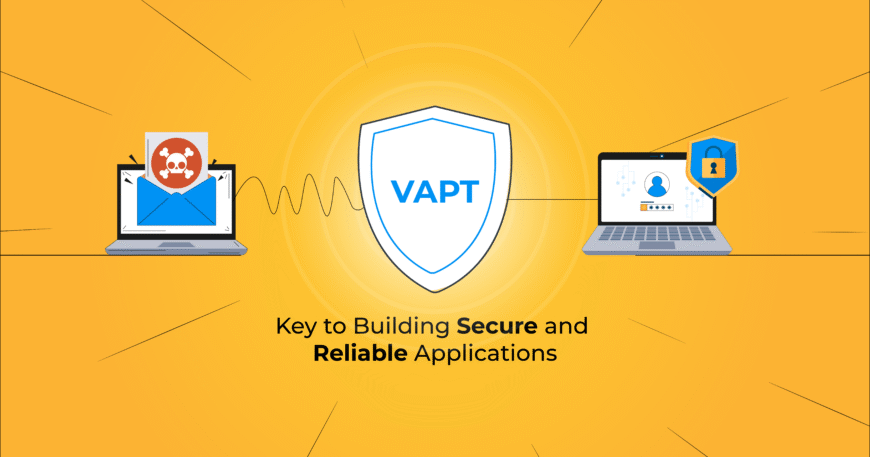Introduction
Today, applications serve as the foundation of enterprises, driving a wide range of sectors, including healthcare, banking, and e-commerce. However, the dangers aimed at applications also become more sophisticated as they do. Failure to safeguard systems puts firms at danger of losing sensitive data, consumer trust, and even revenue due to ransomware attacks and data breaches.
VAPT, or vulnerability assessment and penetration testing, is one of the best methods for finding security flaws and application defenses. To protect our apps, we at Lentera Technologies use VAPT.
What is VAPT Testing?
VAPT testing is a thorough method that blends two effective strategies:
1. Assessment of Vulnerabilities (VA): It aims to identify known security vulnerabilities, configuration errors, out-of-date libraries, and coding problems.2. Testing for Penetration (PT): It goes beyond detection by making an effort to take advantage of the vulnerabilities found in a controlled setting.
How We Applied VAPT Testing to Our Application
At Lentera Technologies, we utilize VAPT ourselves in addition to recommending it. We used a methodical approach when testing our application
1. Establishing the Scope: To make sure testing was focused and efficient, we listed the application’s essential components, such as APIs, authentication modules, payment systems, and data storage layers.2. Scanning for vulnerabilities: We looked for vulnerabilities including SQL injection, cross-site scripting (XSS), inadequate session management, and unsafe APIs using sophisticated techniques.
3. Prioritization and Risk Analysis: The severity, possible business impact, and simplicity of exploitation of each vulnerability were taken into consideration. Critical dangers were identified and addressed right away.
4. Cleaning Up and Retesting: After our developers addressed the vulnerabilities, we carried out additional testing to be sure that every problem had been remedied.
5. In-depth Reporting: Lastly, we produced a thorough report outlining the dangers, exploitation proof-of-concepts, and specific suggestions for enhancing application security.

Best Practices for Using VAPT Testing Correctly
To maximize the benefits of VAPT testing, organizations should:
1. State the Goals: Choose if the emphasis is on risk mitigation, compliance, or bolstering a recent release.
2. Test Frequently: Run VAPT on a regular basis rather than all at once, particularly following significant application changes or the introduction of new features.
3. Balance Automation and Manual Testing: Tools can detect known vulnerabilities quickly, but manual testing uncovers hidden and logic-based flaws.
4. Involve Stakeholders: Developers, testers, and business leaders should all understand the findings and their implications.
5. Act on Recommendations: Identifying vulnerabilities without fixing them leaves systems just as exposed.
Key Benefits of VAPT Testing
1. Proactive Vulnerability Identification: VAPT helps find weaknesses, like misconfigurations or insecure code, before attackers can exploit them.2. Real-World Threat Simulation: Penetration testing simulates actual attacks, demonstrating the impact of vulnerabilities and the effectiveness of existing defenses.
3. Reduced Risk and Cost: By finding and fixing vulnerabilities, VAPT minimizes the risk of financial losses, reputational damage, and operational disruptions from breaches.
4. Enhanced Cybersecurity Posture: Regular testing helps strengthen defenses against evolving cyber threats and improves overall security practices.
5. Regulatory Compliance: VAPT provides documented evidence and helps organizations meet stringent security standards required by industry regulations such as PCI DSS, HIPAA, and GDPR.
6. Improved Incident Response: Insights gained from VAPT can lead to more effective detection and response plans for actual security incidents.
7. Increased Customer Trust: Demonstrating a strong commitment to security through regular VAPT builds confidence and trust with customers and stakeholders.
8. Actionable Remediation Insights: VAPT provides specific recommendations and steps for fixing identified vulnerabilities, enabling more effective security updates and policy changes.
Conclusion
VAPT testing is an essential safety measure for contemporary applications, not only a technical one. VAPT guarantees that your application is resistant to changing threats by detecting vulnerabilities, modeling actual attacks, and verifying remedies. VAPT provides you with the assurance that your digital assets are dependable and safe, regardless of the size of your business application or enterprise system.
Contact us at info@lentera.in right now if you would want to use VAPT testing to increase the security of your application.




